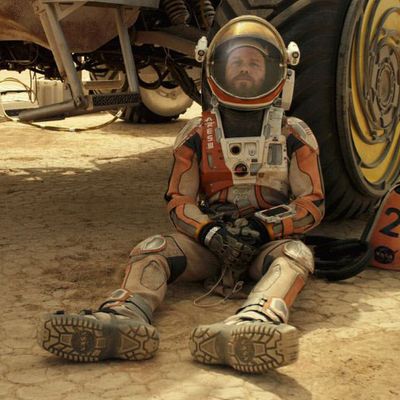
With Ridley Scott’s The Martian hitting theaters Friday, the question on everybody’s mind this weekend is, What would NASA actually do if they really did leave a wisecracking botanist stranded on the surface of the Red Planet? The short answer: They’re not sure yet. As NASA spokesperson Stephanie Schierholz explained to Vulture, the agency is currently working on the Orion spacecraft in the hopes of sending mankind to Mars, “but there are a lot of problems that have to be solved first in terms of getting there. We wouldn’t be into planning contingencies [yet].” In other words, before a plan can go wrong, there has to be a plan. There isn’t a team of Donald Glovers pounding coffee, waiting for an opportunity to discover outside-the-box solutions.
Similarly, the agency isn’t doing moon landings right now, so there’s nothing on the books for rescuing an astronaut from the moon, either. If history is any indication, landing on any sort of planetary body is a gamble that NASA considers impossible to double-down on. Back when he was Richard Nixon’s speechwriter, William Safire, actually drafted a speech in the event that the Apollo 11 crew became stranded on the moon. There was “no hope for recovery,” he wrote: “Fate has ordained that the men who went to the moon to explore in peace will stay on the moon to rest in peace.”
If it weren’t for the example of Matt Damon, the problem would be academic: Space travel as it currently exists doesn’t leave much room for an emergency like one depicted in The Martian, because we’ve stayed relatively close to the Earth. The most recent “emergency” was in 2010, when an ammonia pump on the International Space Station broke sooner than anticipated. When that happened, the crew had to make quick repairs, though quick isn’t really the right word; the problem was fixed by executing three space walks over the course of a month.
The space station is 250 miles away from our planet, so if a situation required a quick escape from the facility, “you could be back on Earth in a matter of hours,” says Schierholz. Soyuz spacecraft have been flying reliably for decades, and NASA is pretty confident in their ability to get astronauts back to Earth safely. There isn’t really a scenario in which astronauts would have to race up to the ISS; as the months-in-the-works rescue mission in The Martian shows, there’s no rapid-response NASCAR pit crew for space launches.
On very rare occasions, NASA will ready two shuttles. “For the last Hubble repair mission, the contingency scenario was that we had two space shuttles on two launch pads ready to launch,” Schierholz recalled. NASA developed a plan to repair the shuttle in case it got damaged in similar fashion to the ill-fated Columbia, “and then, secondarily, they would have a space shuttle on standby, ready to launch that rescue mission, to go to orbit, ready to get the crew members and bring them back.”
Likewise, the ISS almost always has a line of communication with ground control in Houston, which in real life contains a shockingly small number of Chiwetel Ejiofors. If an astronaut runs into unforeseen circumstances while on a space walk, for example, they usually have someone to consult with. NASA produces documentation for pretty much any procedure you can think of, and astronauts use laptops to keep track of everything. “Every day they’re in space is timelined,” Schierholz says. “Every minute of their day is put into a schedule.” That way they can check procedure and act accordingly. (Or, as seen in the movie, go off-script with a daring rescue plan.) Videos are being produced to help astronauts with tasks, and researchers are looking at using augmented reality to relay necessary info via a heads-up display.
Crews do train for a few standard issues that might need to be dealt with, many of which pop up in The Martian. Schierholz said that there are about 14 different scenarios that astronauts prepare for, and they fall into two categories: keeping the primary electrical power system running, and keeping thermal control working as well. You can hear astronauts narrating technical changes they make to the station to mission control on NASA’s livestreams.
Still, all of this communication gets more difficult when you are talking about Mars. At 225,000 miles away, the moon is 900 times farther away from us than the ISS; Mars is exponentially farther than that. “At best, [Mars is] 39 million miles away; on average, [it’s] 140 million miles away.” As a result, traveling to other celestial bodies is “significantly different. You can’t just be back on Earth, so you have to be prepared to be more independent of Earth.” It guess worse: “You’re talking six months just to get to Mars. Then you stay on surface for about 18 months, and then six months to come home,” Schierholz says. “So by the time we send humans to Mars, we have to be incredibly confident that our systems will work, and that the crews can handle things without Earth’s help.” With that distance, there’s a 40-minute communications delay — easily edited down in The Martian, but much less breezy in real life.
So NASA’s not quite sure how to rescue someone stranded on Mars, because a lot of work has to be done first — not the least of which being that we have to figure out how exactly we’re gonna get there. But given how they design systems, a lot of things have to fail for someone to get stuck on the red planet.

